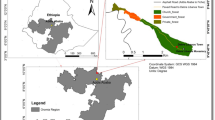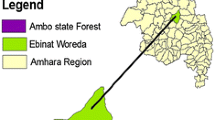Abstract
The naturally regenerated native woody species diversity was studied ineucalypt plantations at Menagesha, where there was remnant natural forest, and atChancho, where natural forests were absent. A total of 22 and 20 woody speciesbelonging to 18 and 17 families were found, and of these species, treesaccounted for 68 and 55% at Menagesha and Chancho, respectively. About 83% ofthe woody species found in the adjacent natural forest, including importanttimber species were represented in the eucalypt understory at Menagesha.However, the relative abundance of species in eucalypt plantations and theadjacent natural forest varied considerably. Woody species richness andabundance of sample plots at Menagesha were on average 2.4 times and 5.7times higher, respectively, than the sample plots at Chancho. This resultdemonstrates the crucial role of the remnant small patches of natural forest,as a source of diaspores for the restoration of the woody species diversity indegraded areas of the Ethiopian highlands. There was no significant differencein woody species diversity between the eucalypt stand margin and centre. Theunderstory woody species density in eucalypt plantations was up to 8325stems/ha, indicating that the numerous eucalypt stands have a highpotential for restoring the woody species diversity in the Ethiopian highlands.In order to fully re-establish the diverse and economically valuable naturalforest, complementary measures such as enrichment planting of missing primaryforest species may be required.
Similar content being viewed by others
References
Basanta M., Vizcaino E.D., Casal M. and Morey M. 1989. Diversity measurements in shrubland communities of Galicia (NW Spain). Vegetatio 82: 105–112.
Bekele T. 1993. Vegetation ecology of remnant afromontane forests of the Central Plateau of Shewa, Ethiopia. Acta Phytogeographica Suecica 79: 1–59.
Bhaskar V. and Dasappa V. 1986. Ground flora in Eucalyptus plantations of different ages. In: Sharma J.K., Nair C.T.S., Kedharnath S. and Kondas S. (eds), Eucalyptus in India: Past, Present and Future. Kerala Forest Research Institute, Peechi, Kerala, India, pp. 213–224.
da Silva J.M.C., Scarano F.R. and Souza F.C. 1995. Regeneration of an Atlantic forest formation in the understory of a Eucalyptus grandis plantation in south-eastern Brazil. Journal of Tropical Ecology 11: 147–152.
Demissew S. 1988. The floristic composition of the Menagesha state forest and the need to conserve such forests in Ethiopia. Mountain Research and Development 8: 243–247.
Eshetu Z. 2000. Forest Soils of Ethiopian Highlands: Their Characteristics in Relation to Site History. Studies based on Stable Isotopes, Ph.D. Thesis, Acta Universitatis Agriculturae Sueciae, Umeå, Sweden.
FAO 1981. Eucalypts for Planting. FAO Forestry and Forest Products Studies 11. FAO, Rome.
FAO 2001. Global Forest Resources Assessment 2000. Forestry Paper 140. FAO, Rome.
Florence R.G. 1986. Cultural problems of eucalyptus as exotics. Commonwealth Forestry Review 65: 141–163.
Friis I. 1992. Forests and Forest Trees of Northeast Tropical Africa. Kew Bulletin Additional Series 15. Her Majesty's Stationary Office, London.
Gamachu D. 1977. Aspects of Climate and Water Budget in Ethiopia. Addis Ababa University Press, Addis Ababa, Ethiopia.
Geldenhuys C.J. 1997. Native forest regeneration in pine and eucalypt plantations in Northern Province, South Africa. Forest Ecology and Management 99: 101–115.
Holgén P. and Svensson M. 1990. Loss of Inorganic Nutrients by Whole Tree Utilization for Firewood in Ethiopia. Working paper 150. Swedish University of Agricultural Sciences, International Rural Development Centre, Uppsala, Sweden.
Horvath R.J. 1968. Addis Ababa's eucalyptus forest. Journal of Ethiopian Studies 6: 13–19.
Lisanework N. and Michelsen A. 1994. Litterfall and nutrient release by decomposition in three plantations compared with a natural forest in the Ethiopian highland. Forest Ecology and Management 65: 149–164.
Lugo A.E., Parotta J.A. and Brown S. 1993. Loss in species caused by tropical deforestation and their recovery through management. Ambio 22: 106–109.
Luometo J.J. and Huttel C. 1997. Understory vegetation in fast-growing tree plantations on savanna soils in Congo. Forest Ecology and Management 99: 65–81.
Madeira M.A.V., Andreux F. and Portal J.M. 1989. Changes in soil organic matter characteristics due to reforestation with Eucalyptus globulus, in Portugal. The Science of Total Environment 81/ 82: 481–488.
Michelsen A., Lisanework N., Friis I. and Holst N. 1996. Comparisons of understory vegetation and soil fertility in plantations and adjacent natural forests in the Ethiopian highlands. Journal of Applied Ecology 33: 627–642.
Otsamo R. 2000. Secondary forest regeneration under fast growing forest plantations on degraded Imperata cylinderica grasslands. New Forests 19: 69–93.
Parrotta J.A. 1992. The role of plantation forests in rehabilitating degraded tropical ecosystems. Agriculture Ecosystem and Environment 41: 115–133.
Parrotta J.A. 1993. Secondary forest regeneration on degraded tropical lands. The role of plantations as foster 'ecosystems'. In: Lieth H. and Lohman M. (eds), Restoration of Tropical Forest Ecosystems. Kluwer, Dordrecht, the Netherlands, pp. 63–73.
Parrotta J.A. 1995. Influence of overstory composition on understory colonisation by native species in plantations on a degraded tropical site. Journal of Vegetation Science 6: 627–636.
Pohjonen V. and Pukkala T. 1990. Eucalyptus globulus in Ethiopian forestry. Forest Ecology and Management 36: 19–31.
Poore M.E.D. and Fries C. 1985. The Ecological Effects of Eucalyptus. Forestry Paper 59. FAO, Rome.
Shiva V. and Bandyopadhyay J. 1983. Eucalyptus – a disastrous tree for India. The Ecologist 13: 184–187.
Tedla S. and Gebre M. 1995. Biodiversity Management in Ethiopia. Regional Workshop on Biodiversity Management in Africa: Creating National Systems of Conservation and Innovation. African Centre for Technology Studies, Nairobi, Kenya.
Steege H. 1997. Winphot, a programme to analyze vegetation indices, light and light quality from hemispherical photographs. Tropenbos-Guyan Programme/ Utrecht University, Utrecht, the Netherlands.
Turnbull J.W. and Pryor L.D. 1978. Choice of species and seed source. In: Hillis W.E. and Brown A.G. (eds), Eucalyptus for Wood Production. CSIRO, Adelaide, Australia, pp. 6–65.
Turner I.M. and Corlett R.T. 1996. The conservation value of small, isolated fragments of lowland tropical rainforest. Trends in Ecology and Evolution 11: 330–333.
White F. 1983. The vegetation of Africa. A descriptive memoir to accompany the UNESCO/AETFAT/ UNSO Vegetation map of Africa. UNESCO, Paris.
World Conservation Monitoring Centre 1992. Global Biodiversity. Status of the Earth's Living Resources. Chapman & Hall, London.
Wunderle J.M. 1997. The role of animal seed dispersal in accelerating native forest regeneration on degraded tropical lands. Forest Ecology and Management 99: 223–235.
Yirdaw E. 2001. Diversity of naturally regenerated native woody species in forest plantations in the Ethiopian highlands. New Forests 22: 159–177.
Rights and permissions
About this article
Cite this article
Yirdaw, E., Luukkanen, O. Indigenous woody species diversity in Eucalyptus globulus Labill. ssp. globulus plantations in the Ethiopian highlands. Biodiversity and Conservation 12, 567–582 (2003). https://doi.org/10.1023/A:1022483700992
Issue Date:
DOI: https://doi.org/10.1023/A:1022483700992




